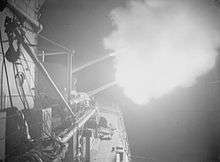HMS Orion (85)
.jpg) | |
| History | |
|---|---|
| Name: | HMS Orion |
| Builder: | Devonport Dockyard/Vickers Armstrong, Barrow-in-Furness |
| Laid down: | 26 September 1931 |
| Launched: | 24 November 1932 |
| Commissioned: | 18 January 1934 |
| Decommissioned: | 1947 |
| Identification: | Pennant number: 85 |
| Fate: | Sold for scrap 19 July 1949 |
| General characteristics | |
| Class and type: | Leander-class light cruiser |
| Displacement: |
|
| Length: | 554.9 ft (169.1 m) |
| Beam: | 56 ft (17 m) |
| Draught: | 19.1 ft (5.8 m) |
| Installed power: | 72,000 shaft horsepower (54,000 kW) |
| Propulsion: |
|
| Speed: | 32.5 knots (60 km/h) |
| Range: | 5,730 nm at 13 knots |
| Complement: |
|
| Sensors and processing systems: |
|
| Armament: |
|
| Armour: |
|
| Aircraft carried: |
|
HMS Orion was a Leander-class light cruiser which served with distinction in the Royal Navy during World War II. She received 13 battle honours, a record only exceeded by HMS Warspite, and matched by two others.
History
Orion was built by Devonport Dockyard (Plymouth, U.K), Vickers-Armstrong (Newcastle-on-Tyne, UK).

Orion was commissioned on 18 January 1934, for service with the Home Fleet but she was transferred to the North America and West Indies Station in 1937 where she was with the 8th Cruiser Squadron. The cruiser conveyed the ashes of Lord Tweedsmuir, Governor-General of Canada, back to England in February 1940.
In June 1940 she was transferred to the Mediterranean, where she was with the 7th Cruiser Squadron as John Tovey's flagship. She took part in the bombardment of Bardia, and the Battle of Calabria in July 1940. Late in that months, she sank the small Greek freighter Ermioni which was ferrying supply to the Italian-held Dodecanese islands.[3] During the rest of 1940 she escorted Malta convoys and transported troops to Greece. In the early part of 1941 she was in the Crete and Aegean areas and was also at the Battle of Cape Matapan in March 1941.
During an attack on a German convoy headed for Crete on 22 May, she was damaged in a duel with its escort, the Italian torpedo boat Lupo. On 29 May 1941, during the evacuation of Crete, she was bombed and badly damaged while transporting 1900 evacuated troops. Around 360 lives were lost, of whom 100 were soldiers. After extensive damage control had been undertaken she limped to Alexandria at 12 knots (22 km/h; 14 mph), providing a spectacular sight in the harbour with the mast wedged into the ship’s funnel and significant battle damage. On 29 June Orion sailed for passage to Simonstown, South Africa via Aden for temporary repairs and then sent to the Mare Island Naval Shipyard in Vallejo, California for major repairs.[4]
Orion's repairs were completed in March 1942 and she returned initially to Plymouth where new radar was installed. During mid 1942, she was widely employed, in home waters and on convoy escort duties to Africa and the Indian Ocean.[4]
Orion returned to the Mediterranean in October 1942. This time she was with the 15th Cruiser Squadron. She was involved in convoy escort duties and supported the army in the invasion of Sicily. She spent most of the rest of the war around the Mediterranean. She also took part in the Normandy Landings in June 1944, where she fired the first shell.
Corfu Channel Incident
Orion was involved in the Corfu Channel Incident.
John Buchan
HMS Orion carried the ashes of former Governor General of Canada John Buchan back to England for burial in February 1940.
Fate
Orion ended service in 1947, was sold for scrap to Arnott Young (Dalmuir, Scotland) on 19 July 1949 and was scrapped in August 1949.
Battle honours
- Atlantic 1939;
- Calabria 1940, Mediterranean 1940-43-44;
- Malta Convoys 1941, Matapan 1941, Greece 1941, Crete 1941;
- Sicily 1943, Salerno 1943;
- Aegean 1944, Anzio 1944, Normandy 1944, South France 1944.
Only Jervis and Nubian, who served in the Mediterranean with Orion matched this record; it was exceeded by Warspite, the Mediterranean Fleet flagship, which saw service in both World Wars.
Notes
- ↑ Lenton & Colledge 1968 p.39
- ↑ Campbell 1985 p.34
- ↑ Greene, J.; Massignani, A. (2002) [1998]. The Naval War in the Mediterrnean 1940–1943 (pbk. ed.). Rochester: Chatham, p. 86. ISBN 978-1-86176-190-3.
- 1 2 Mason, Lt Cdr Geoffrey B (2005). "HMS Orion – Leander-class Light Cruiser". Service Histories of Royal Navy Warships in World War 2. Retrieved 13 July 2010.
References
- Campbell, John (1985). Naval Weapons of World War Two. Naval Institute Press. ISBN 0-87021-459-4.
- Colledge, J. J.; Warlow, Ben (2006) [1969]. Ships of the Royal Navy: The Complete Record of all Fighting Ships of the Royal Navy (Rev. ed.). London: Chatham Publishing. ISBN 978-1-86176-281-8. OCLC 67375475.
- Lenton, H.T.; Colledge, J.J (1968). British and Dominion Warships of World War Two. Doubleday and Company.
- HMS Orion at Uboat.net
External links
| Wikimedia Commons has media related to HMS Orion (85). |